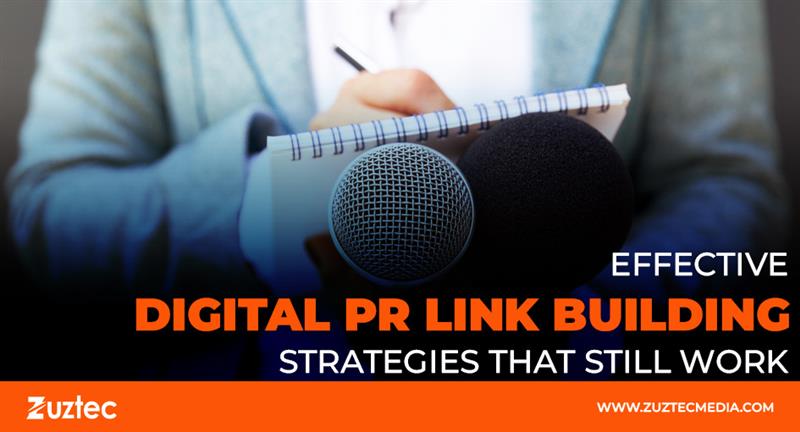
Effective Digital PR Link Building Strategies That Still Work
In today’s highly competitive digital landscape, traditional SEO tactics alone are no longer enough to achieve lasting visibility. Brands need innovative strategies that not only boost rankings but also build authority and brand recognition. By merging public relations with SEO goals, digital PR link building allows businesses to earn high-quality backlinks from credible publications. These links are not just for rankings—they drive referral traffic, build reputation, and contribute to long-term online success.
Digital PR link-building combines content marketing, storytelling, and outreach to earn media coverage. It’s a powerful way to get featured on top-tier sites like Forbes, TechCrunch, or niche industry blogs. The key difference from standard link building lies in the value of the links: they are editorially placed, relevant, and often from high domain authority sources. This makes them more sustainable and trusted by search engines like Google.
It can help you become a recognized authority in your field, drive organic mentions, and even boost conversion rates through increased visibility. In this article, we’ll explore what makes digital PR link-building effective, how it differs from other methods, and how to implement it in your marketing strategy.
What Is Digital PR Link Building And Why Does It Matter
Digital PR link-building is the process of creating newsworthy content and pitching it to journalists, bloggers, and media outlets to gain authoritative backlinks. This strategy goes beyond typical outreach emails by leveraging strong storytelling, original data, and media-friendly formats to earn editorial placements.
Unlike conventional SEO link-building tactics—like guest posting or directory submissions—digital PR focuses on earning links through value-driven content. For example, you might commission a survey, publish original research, or create a compelling story about your brand or customers. Once you have something newsworthy, you pitch it to relevant media contacts and aim to get coverage that includes a backlink to your site.
This method not only gets you high-quality links but also helps build credibility and awareness for your brand. Journalists and editors are more likely to link to sources they trust and find valuable, which is why digital PR has become such an important part of modern SEO strategies.
Key Elements Of A Successful Digital PR Campaign
For digital PR to work effectively, your campaign must include a few essential elements: research, strategy, storytelling, outreach, and follow-up. Each step plays a vital role in determining the overall success and quality of the links you earn.
First, start with research. Understand your audience, industry trends, and the kind of stories that resonate with journalists in your niche. Look at what type of content gets picked up in your field and how you can offer something better or different. Competitor backlink analysis can also reveal opportunities where other brands have gained media coverage.
Second, build your strategy. Choose the right content format—whether it’s a press release, infographic, data study, or expert insight—and tie it into something timely or emotionally engaging. Make sure your content offers value to the publication’s audience, not just your own.
The Role Of Storytelling In Digital PR
Storytelling is what sets digital PR link-building apart from basic SEO tactics. It humanizes your brand and makes your content more shareable and link-worthy. Instead of simply pushing product pages or keywords, digital PR focuses on crafting narratives that engage, inform, or entertain.
For example, a cybersecurity company might share insights from a new survey on online privacy concerns. A food brand might launch a campaign around sustainability with personal stories from farmers. A tech company could release a report on how AI is changing their industry, backed with real data. These types of stories give journalists a reason to write about your brand beyond just marketing.
During the execution phase, make sure your digital PR link building efforts are aligned with your brand voice, audience needs, and current media trends. This blend of strategy and creativity is what drives long-term link equity and visibility.
Common Challenges And How To Overcome Them
Despite its effectiveness, digital PR link-building is not without its challenges. One major issue is getting journalists to respond to your pitches. With inboxes overflowing, many quality pitches go unread. To overcome this, ensure your subject lines are compelling and your pitches are brief, relevant, and personalized.
Another challenge is creating truly newsworthy content. Not every brand has access to original data or big budgets. However, you can still create valuable content by using publicly available data, collaborating with influencers, or offering expert commentary on trending topics. Focus on providing a fresh perspective or unique insight that adds value.
Why Digital PR Should Be Part Of Your SEO Strategy
Digital PR link building is no longer a bonus tactic—it’s a core component of modern SEO. With search engines prioritizing authority, relevance, and trust, traditional link-building techniques often fall short. Digital PR fills that gap by delivering high-quality, contextual backlinks that align with what Google values most.
In addition to boosting your rankings, digital PR helps build brand awareness, media relationships, and thought leadership. These intangible benefits pay off in visibility, trust, and traffic over time. It also integrates well with other marketing strategies like content marketing, social media, and influencer outreach.

